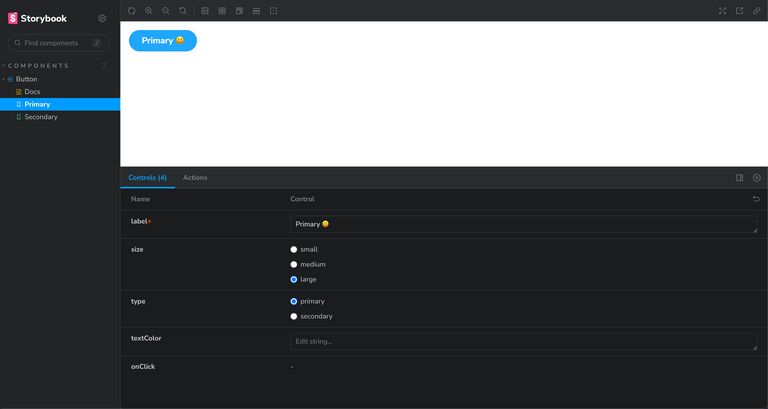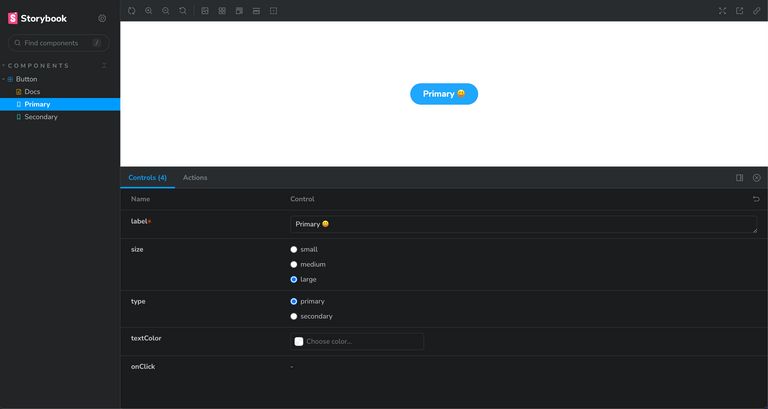If you have multiple projects that are using the same design system (inputs, buttons, other reusable components, etc.), then you probably have a good enough use case to create a shared component library that can be published and consumed directly by all your projects.
Another benefit is that you can develop UI components easily in isolation and render their different states directly, without needing to mess with the business logic in your dev stack, with the help of Storybook.

In this tutorial, I would be covering the steps for creating and publishing a React component library (Storybook supports countless other frontend frameworks), with the following steps.
- Setting up the project
- Installing Storybook
- Adding stories and setting up the file structure
- Compiling the Library using Rollup
- Publishing and consuming the library
You can find all the code that we will be writing in this tutorial on GitHub.
Setting up the project
Since we are building a component library that would be published to a package manager we would be creating a new package from scratch.
For that, create a new folder with whatever name you want for your component library. I would be calling mine my-awesome-component-library.
Then run yarn init and git init, respectively, in that folder providing appropriate values for the fields asked. This would initialize an empty NPM project with git. Also, set up a gitignore file.
We are building a React component library, so we would need to React to build our components. Also, we are going to use TypeScript to build our library. Let's add that too.
yarn add --dev react react-dom @types/react typescriptSince react requires that we need to have a single copy of react-dom, we will be adding it as a peerDependency so that our package always uses the installing client's version. Add the following snippet to your package.json.
...
"peerDependencies": {
"react": "^18.2.0",
"react-dom": "^18.2.0"
},
...As one last step for setting up the project, let's also add a tsconfig for compiling our TypeScript. Create a file called tsconfig.json in the root and add the following to it.
{
"compilerOptions": {
"target": "es5",
"outDir": "lib",
"lib": ["dom", "dom.iterable", "esnext"],
"declaration": true,
"declarationDir": "lib",
"allowJs": true,
"skipLibCheck": true,
"esModuleInterop": true,
"allowSyntheticDefaultImports": true,
"strict": true,
"forceConsistentCasingInFileNames": true,
"module": "esnext",
"moduleResolution": "node",
"resolveJsonModule": true,
"isolatedModules": true,
"noEmit": true,
"jsx": "react"
},
"include": ["src"],
"exclude": ["node_modules", "lib"]
}These options help TypeScript to ignore and enforce certain rules while compiling our code. You can check out all the flags available in the docs.
Installing Storybook
Now that we have the React boilerplate ready we can now install Storybook, run the following command in the root folder to add Storybook to your project
npx sb initThis command will install all the core devDependencies, add scripts, setup some configuration files, and create example stories for you to get you up and running with Storybook. The Storybook version has been updated to 7.0.11 since this article was first published.
You can now run yarn storybook and that should boot up Storybook for you with the examples they created for you.
Once you are done playing with the example, you can go ahead and safely delete the stories folder.
Now open the .storybook/main.js file. This file controls the behavior of your Storybook server by specifying the configuration for your stories.
Update the stories key in the file to this -
...
"stories": [
"../src/**/*.stories.tsx"
],
...This config would run TypeScript stories defined in the src folder, which we would be creating in the next step.
Adding stories and setting up the file structure
Now that we have the Storybook setup, we can start creating our components and writing stories for them.
But first of all what are stories anyways?
Glad you asked, from the docs -
A story captures the rendered state of a UI component. Developers write multiple stories per component that describe all the “interesting” states a component can support.
In short, Stories let you render the different states of your UI component and lets you play with the different states with something called Storybook Controls, which we will get to in a minute. These are development only files and hence won't be included in our final library bundle.
Let's create a demo component to check out how stories work and how you can make the most out of it.
Our file structure would look something like this -
.storybook/
main.js
preview.js
.gitignore
package.json
rollup.config.mjs
tsconfig.json
src/
components/
MyAwesomeComponent/
MyAwesomeComponent.tsx
MyAwesomeComponent.css
MyAwesomeComponent.stories.tsx
index.ts
index.tsWe will be using the same button component that Storybook gave us with the demo earlier for demonstrating.
Create a folder src/components/Button and paste the Button.tsx, button.css, and index.ts files in it.
Lets add some stories ✨
Create src/components/Button/Button.stories.tsx
Now add the following default export to it -
import React from "react";
import type { Meta, StoryObj } from "@storybook/react";
import Button from "./Button";
const meta: Meta<typeof Button> = {
title: "Components/Button",
component: Button,
};Storybook uses the Component Story Format (CSF) which is an open standard for UI component examples based on JavaScript ES6 modules.
The default export in a story defines the metadata that controls how Storybook lists your stories. It mainly includes the title, the component that the story will render and other options that can be used to further customize the story.
To define a Story you need to create named exports in the file. These named exports are objects that represent a single story of your component and can override certain metadata defined in the default export. For example, we can create a story for the Primary state of button by adding the following code to the Button.stories.tsx file:
type Story = StoryObj<typeof Button>;
export const Primary: Story = {
args: {
label: "Primary 😃",
size: "large",
type: "primary",
},
};Here the args object represent the default props that will be passed to our Button component when the story is rendered, although these props are also configurable by Storybook controls which we will get to in a minute.
Similarly you can create a story for the secondary state for the Button component that will have secondary variant as the default when the story is rendered. Add the following code to the Button.stories.tsx file to test it out yourself:
export const Secondary: Story = {
args: {
...Primary.args,
type: "secondary",
label: "Secondary 😇",
},
};If you haven't already, you can restart the Storybook server by rerunning yarn storybook, and you should see the following.

Notice that Storybook automatically generated the controls, according to the component props, for us. This is thanks to react-docgen-typescript, which is used by Storybook to infer the argTypes for a component. One more reason to use TypeScript.
Apart from using auto-generated controls, you can also define custom controls for some or all props using the argTypes key. For example, let's define a custom color picker for the textColor prop. Add the argTypes key to the default metadata export in the Button.stories.tsx file:
const meta: Meta<typeof Button> = {
title: "Components/Button",
component: Button,
argTypes: {
textColor: { control: "color" },
},
};The current story preview also looks a bit weird with the button in one corner of the preview. As one last step, add the layout: 'centered' key to the .storybook/preview.js file to center the preview. This file lets you control how your story is rendered in the Storybook.
If you followed the above steps, your final story preview would look something like this -

There's a lot more configuration you can do with your stories, like customizing story parameters, using decorators, extend your Storbook UI behaviour with addons, etc. But that would be out of scope of this tutorial and is covered in much more detail in the official Storybook documentation.
Compiling the Library using Rollup
Now that you know how to build components with Storybook, it's time to move to the next step, which is compiling and bundling our library so that our end applications can consume it.
We will be using Rollup to bundle the library. If you're not familiar with Rollup I would recommend checking out this article by Rich on why its better to use Rollup for libraries and Webpack for apps.
First, we would need to create an entry file that would export all the components for our component library. Create src/index.ts, and since our component library only has one component right now, it would look something like this -
import Button from "./components/Button";
export { Button };Let's add rollup, run the following to install Rollup and its plugins that we'll be using to bundle the library -
yarn add --dev rollup @rollup/plugin-typescript @rollup/plugin-commonjs @rollup/plugin-node-resolve rollup-plugin-peer-deps-external rollup-plugin-postcss rollup-plugin-dts postcssNow before we add the rollup config, there are a few types of JavaScript modules that you should be aware of -
- CommonJS - This module format is most commonly used with Node using the
requirefunction. Even though we are publishing a React module (which will be consumed by an application generally written in ESM format, then bundled and compiled by tools like webpack), we need to consider that it might also be used within a Server side rendering environment, which generally uses Node and hence might require a CJS counterpart of the library (ESM modules are supported in Node environment as of v10 behind an experimental flag). - ESM - This is the modern module format that we normally use in our React applications in which modules are defined using a variety of import and export statements. The main benefit of shipping ES modules is that it makes your library tree-shakable. This is supported by tools like Rollup and webpack 2+.
- UMD - This module format is not as popular these days. It is required when the user requires our module using a script tag.
So we would want to support both ESM and CommonJS modules for our component library so that all kinds of support tools can use it in the end application that relies on either of the module types.
To do that, package.json allows adding the entry points for both ESM and CommonJS modules via the module and main key, respectively. So add the following to keys to your package.json -
{
...
"main": "lib/index.js",
"module": "lib/index.esm.js",
"types": "lib/index.d.ts",
...
}The types key would point to the static types generated for your library via Rollup, which would help with IntelliSense in code editors like VSCode.
Its time to add the Rollup config file now, create a file called rollup.config.mjs in the root folder and add the following to it -
import peerDepsExternal from "rollup-plugin-peer-deps-external";
import resolve from "@rollup/plugin-node-resolve";
import commonjs from "@rollup/plugin-commonjs";
import typescript from "@rollup/plugin-typescript";
import postcss from "rollup-plugin-postcss";
import dts from "rollup-plugin-dts";
// This is required to read package.json file when
// using Native ES modules in Node.js
// https://rollupjs.org/command-line-interface/#importing-package-json
import { createRequire } from 'node:module';
const requireFile = createRequire(import.meta.url);
const packageJson = requireFile('./package.json');
export default [{
input: "src/index.ts",
output: [
{
file: packageJson.main,
format: "cjs",
sourcemap: true
},
{
file: packageJson.module,
format: "esm",
sourcemap: true
}
],
plugins: [
peerDepsExternal(),
resolve(),
commonjs(),
typescript(),
postcss({
extensions: ['.css']
})
]
}, {
input: 'lib/index.d.ts',
output: [{ file: 'lib/index.d.ts', format: 'es' }],
plugins: [dts()],
external: [/\.css$/]
}];Let's break it down one by one to figure out what's happening here. We are export an array from the config file which contains to objects, each with their input and output targets.
Starting with the first one, the input key indicates the entry point for Rollup for our component library, which is the index.ts file that we just created, which contains the exports for all our components.
The output key indicates what types of output files will be generated at which place. As mentioned previously, we would be building the ESM and CommonJS bundles, and we read the output file paths for both bundles from the package.json.
The second object is for bundling type declarations and is discussed in the plugins section below.
Lastly there is the plugin array with which we are using the following plugins -
- rollup-plugin-peer-deps-external - This plugin avoids us from bundling the
peerDependencies(reactandreact-domin our case) in the final bundle as these will be provided by our consumer application. - @rollup/plugin-node-resolve - This plugin includes the third-party external dependencies into our final bundle (we don't have any dependencies for this tutorial, but you'll definitely need them as your library grows).
- @rollup/plugin-commonjs - This plugin allows the rollup plugin to convert CommonJS modules to ESModules so that Rollup can bundle them together with other ES modules.
- @rollup/plugin-typescript - This plugin compiles the TypeScript code to JavaScript for our final bundle and generates the type declarations for the
typeskey inpackage.json. - rollup-plugin-postcss - This plugin helps include the CSS that we created as separate files in our final bundle. It does this by generating minified CSS from the *.css files and includes them via the
<head>tag wherever used in our components. - rollup-plugin-dts - This plugin bundles all the type declarations into a single file. Although the TypeScript plugin generates the type declarations for our library but they are scattered across the files. This plugin helps us bundle them into a single file. We use the type declarations generated by the TypeScript plugin as the input for this plugin and override the declaration file.
Now as one last step let's add the script to build our component library, add the following script to your package.json file -
{
...
"scripts": {
...
"build": "rollup -c"
},
...
}Go ahead and run yarn build from your terminal and you should be able to see the lib folder created. I would recommend exploring this folder further to understand how Rollup and its plugins generate the appropriate bundles for the CommonJS and ESM modules with the type definitions.
Don't forget to add the lib folder to .gitignore.
Publishing and consuming the library
Publishing the library to NPM couldn't be any easier. Since we have already defined all the required fields in package.json, you just need to run npm publish.
Once published, you should be able to import your component from your library in the consumer application just like this -
import { Button } from "my-awesome-component-library";You can also refer to my another article for the detailed steps and best practices for publishing a library to NPM.
You might also want to keep your library private. If you have multiple projects in a monorepo and are using something like yarn workspaces, then you don't actually need to publish the package anywhere.
Place the library folder in your monorepo and add it to your workspaces array to the package.json in the root folder -
// package.json
{
...
"workspaces": [
...
"my-awesome-component-library"
],
...
}Then you can directly access it from any other package in your workspace by just adding it as an dependency:
// my-awesome-frontend/package.json
{
...
"dependencies": {
...
"my-awesome-component-library": 1.0.0,
...
},
...
}And that's it. You now have a component library which you can build in isolation and preview using storybook and consume in your application as a package. You can find all the code for this tutorial on Github.
Next Steps
- Integrate Netlify or some other service to automatically deploy the Storybook whenever a PR is merged into master and to generate pull previews whenever a new PR is opened.
- Setup test cases using React Testing library and Jest.
- Make the library tree-shakeable so that your consumer application only ends up including the components that are used in the application instead of the entire library.

